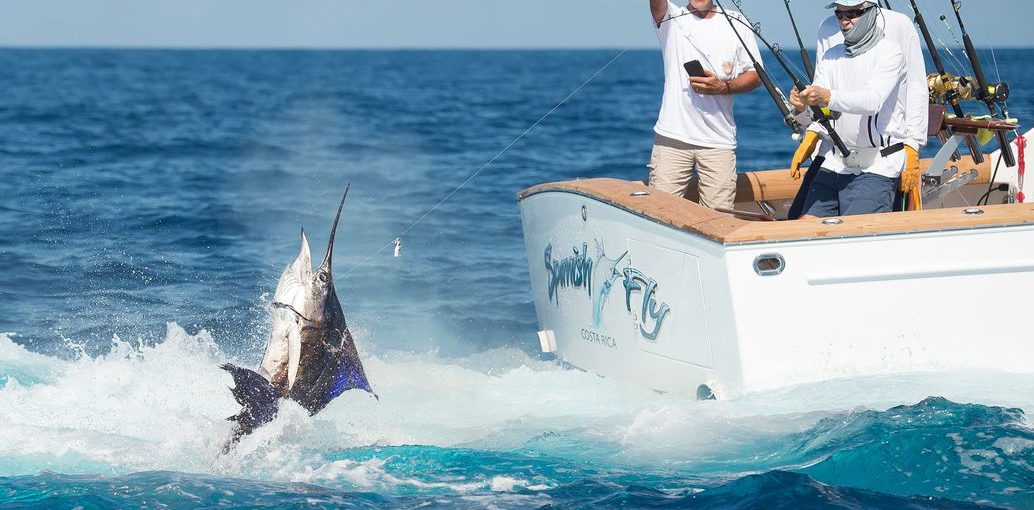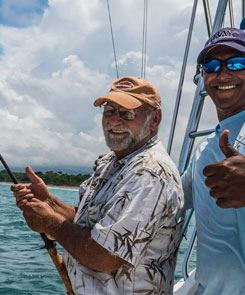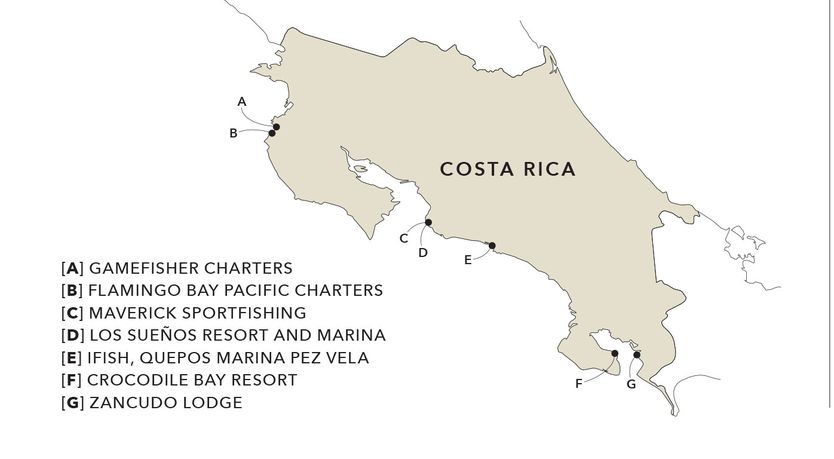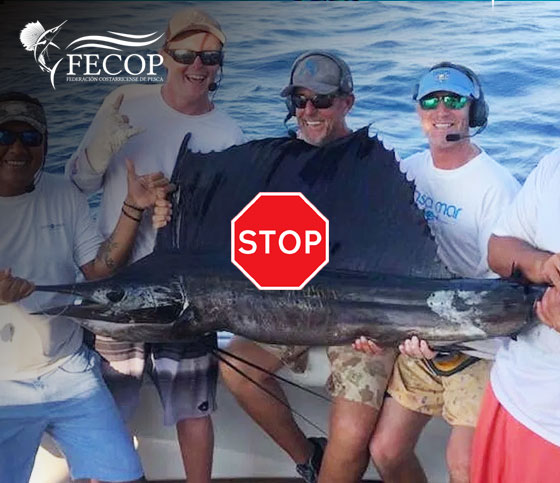Tips to Help You Plan the Perfect Costa Rica Fishing Trip
Time to chase away the Covid blues with a fishing vacation in Costa Rica
Update: Costa Rica is now open to all USA States and most countries for sport fishing trips. Additional insurance is required but 72 hour Covid19 testing is no longer required (see Covid19 Costa Rica entry requirement updates here). Fishing lodges and charters from North to South are reporting better than usual activity for this time of year and we can only assume the bite, especially offshore, will only continue to get better as we approach Costa Rica’s peak tourism season. At only 2 1/2 hours from Miami – Costa Rica is a great option for blue water fishing as well as great inshore action. Read our fishing guide below for more information.

With hundreds of fishing lodges and charters offering Costa Rica fishing vacations and charter boats, selecting the right operation can be a daunting task. With it’s two coasts, volcanic structure, diverse fisheries, and traveler friendly tourism infrastructure, Costa Rica is definitely a great destination for your dream fishing vacation. The following article should give you a solid foundation for choosing and customizing the ideal fishing vacation for you.
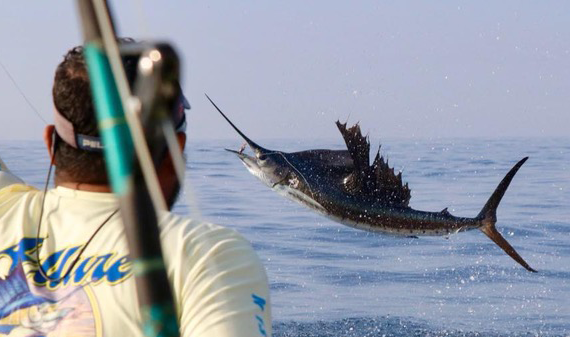
Please read the laws and regulations before your trip!
Costa Rica Fishing – Before You Go
Set Your Expectations
” The size and quantity of fish you catch will be directly proportionate to how much you deserve it.”
Hopefully after reading this fishing guide you will have a better understanding of what to expect on your Costa Rica fishing trip.
Do Your Research (and we have done most of it for you right in this guide)
A bucket list caliber fishing trip requires planning and research – but the time you put in is worth it as you will surely come away with some amazing stories, and not just about the fish you release. Costa Rica is one of the most biologically and geographically diverse places on Earth which means wild coastal jungle and beaches offering access to the Pacific and Atlantic Oceans as well as a Caribbean Coast. The mountains, wildlife and trees/plants as well as fresh water river and lakes make the backdrop to your fishing adventure. The feeling of fishing off Costa Rica’s volcanic coasts is so surreal you may need your partner to “pinch” you so you know you’re not dreaming. Also there is a lot more to Costa Rica then just the fishing.
Top Ten Questions to Ask Your Charter Captain or Lodge contact before your fishing trip in Costa Rica
Is a fishing license included in the trip?
What kind of fishing gear do you use. Can I bring my own?
Does the Captain or crew speak English? (very helpful if at least one of the crew members speaks English. Communication is key)
Do you release all billfish and roosterfish? (legal requirement)
Do you use circle hooks on live bait? (required by law)
Do you leave billfish in the water for photos? (legally required)
Do you partner with a fish tagging organization like Gray Fishtag?
Is bait ready, or do we have to catch it before we start our full or half day fishing?
How many hours of fishing is included in a full day? Half day?
How long has your captain(s) fished the area near your lodge/charter?
The Costa Rica “Pura Vida” Culture
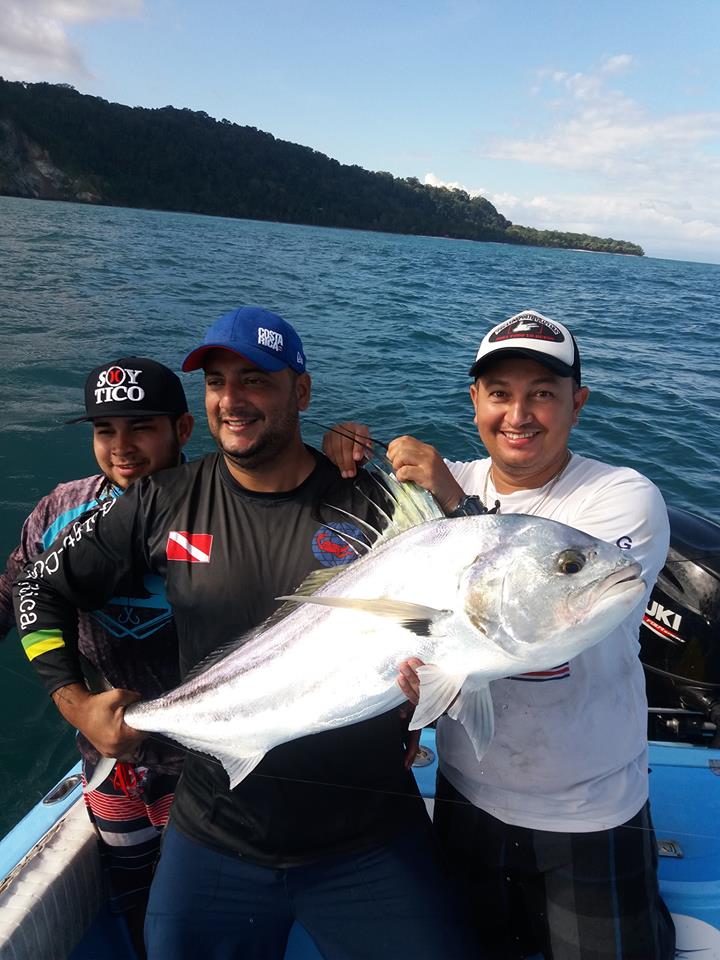 In Costa Rica, aside from a “Gringo or two” you will be fishing with the local people. The friendliness of the people and culture is second to none and many of the locals speak English – however if you speak Spanish they really appreciate it and have fun learning about your culture as well. Costa Ricans are laid back with their mantra being “Pura Vida” or Pure Life. It is not “cool” to be in a hurry. So practice your tranquilo. As with any country/culture you will also run into a few “jerks” and if so just move on. Costa Rica’s people or “Ticos and Ticas” are very proud and condescending to them is not recommended if you want to enjoy your trip. If you experience bad service or attitude in the country let your tip do the talking and go on about your day. The locals in fishing areas KNOW how to fish – probably better than you. So if you are lucky enough to get some advice, take it. Leave everything you think you know about fishing at home and get ready for a whole new experience.
In Costa Rica, aside from a “Gringo or two” you will be fishing with the local people. The friendliness of the people and culture is second to none and many of the locals speak English – however if you speak Spanish they really appreciate it and have fun learning about your culture as well. Costa Ricans are laid back with their mantra being “Pura Vida” or Pure Life. It is not “cool” to be in a hurry. So practice your tranquilo. As with any country/culture you will also run into a few “jerks” and if so just move on. Costa Rica’s people or “Ticos and Ticas” are very proud and condescending to them is not recommended if you want to enjoy your trip. If you experience bad service or attitude in the country let your tip do the talking and go on about your day. The locals in fishing areas KNOW how to fish – probably better than you. So if you are lucky enough to get some advice, take it. Leave everything you think you know about fishing at home and get ready for a whole new experience.
“So, here comes the million dollar question that echoes through the halls of the FECOP office and the Costa Rican mountains all the way to the sea and coconut tree”
When is a Good Time to go Fishing in Costa Rica?
Short answer: The fishing in Costa Rica is always “good”
On any given day one could receive a thousand different responses to this “most frequently asked question” about fishing in Costa Rica. But depending on the region of Costa Rica you happen to be in, the time of year, weather conditions, the tide, the moon, and the possibility of larger natural phenomenon e.g. El Nino or La Nina, it could be excellent or good any day of the year.
Bad or skunk days do happen as in any other global fishing destination. But the only place you have the chance for a perfect day of coming away with everything you want is in your local fish market. I guess this is part of what makes fishing so much fun. What’s on my line, can I get it to the boat, can I tag and release it? can I name this Marlin? The element of the unknown followed by the fight and then the release into the blue waters or in some cases your stomach is what makes this whole experience great. For this optimal story to play out you have to control and plan as much of the trip as you can from the reputation of your captain (communication is key – does he or anyone on the boat speak English? Do you speak Spanish?) and mates, your preparedness, the equipment, lures, line, reels down to the boats ability to get you to the right places and back to your base camp with dinner and exaggerations and outright lies of the ones that got away (all part of fishing by the way).
Costa Rica Fishing Calendar
Luckily groups like FECOP have compiled years of catch data to produce fishing calendars that can give anglers “The best historical times of the year to fish and where to fish in Costa Rica for specific target sport fishing species.
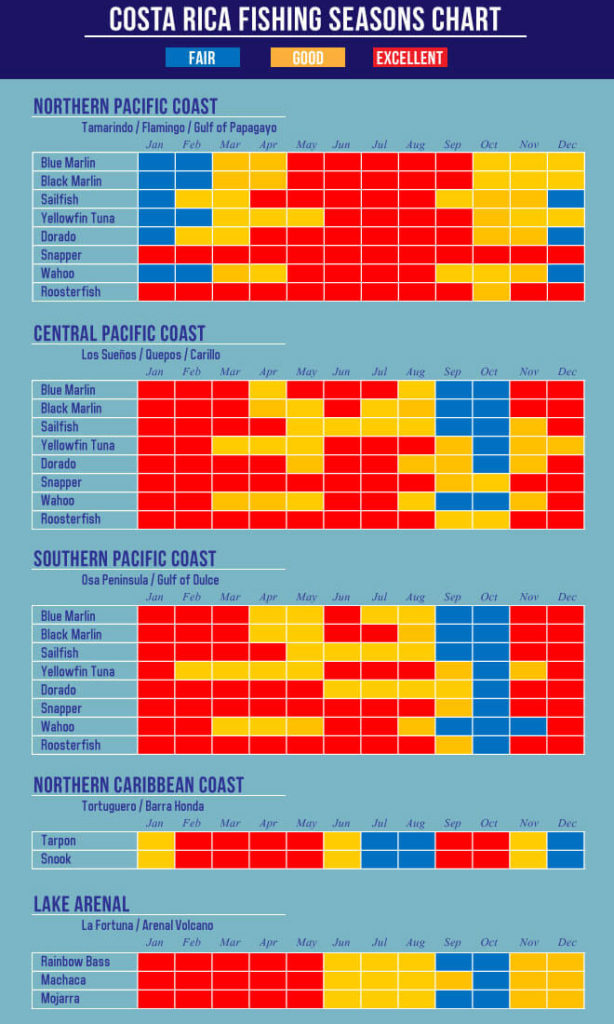
Fishing Map Courtesy www.vacationscostarica.com
The most popular time to fish the Pacific in Costa Rica is December through May. This is when we see the probability of catching Costa Rica’s most popular fish or billfish, the Pacific Sailfish (Southern and central Pacific coast), increases greatly, especially between the months of February and April. It also happens to be the time of year when most people take vacations in the USA, Canada and Europe to escape the cold weather. This is also where geography comes into play, as the sailfish bite shifts a bit depending on how far North or South you are in Costa Rica and what species you want to target. Learn more about the currents that push sailfish from oxygen depleted waters into pockets (formed by Humboldt and California currents) along Costa Rica’s coast and the annual sailfish migration in the article by Todd Staley Sailfish for Dummies
What Kind of Fish Do you Want to Target in Costa Rica?
For some the answer is simple. “Anything that will bite” is an answer we get a lot and it’s not a bad response. People who come and say “I want a marlin or I am going to be upset” will probably not get that marlin and the green horn next to him will. Costa Rica really is famous for it’s diversity of saltwater species which varies inshore and offshore. Pacific sailfish, blue, black and striped marlin, dorado, whaoo and tuna are the prized species offshore. Inshore is like an anglers “candy shop” as one could catch 7 or more species in a single day including several variety of snapper with Cubera being the most popular. Roosterfish, probably the most popular inshore species in Costa Rica for its fighting and jumping ability and and can be caught any day of the year. Again, all fish mentioned below can be caught any day of the year, some months however your chances are historically much better to see bigger numbers, mainly with pelagics such as marlin and sailfish.
Fly Fishing or Conventional
If you’re a fly fisherman your in luck. One of the most thrilling experiences you can have is a sailfish on the fly They love big pink flys and its a short pitch to the fish when it come up in the spread. If you’re interested in catching a sailfish on the fly for your first time check out this article – catching your first sailfish on the fly here
Sport Fishing Species of Costa Rica

See our in-depth guide to Costa Rica’s Fishing Species Here
Offshore
Inshore
- Cubera Snapper
- Roosterfish
- African Pompano
- Bluefin Trevally
- Jacks
- Snook
- Trippletail
- Mackerel
- Grouper
- Needlefish
Carribbean Side
- Tarpon
- Snook
Costas Rica Regions
- Guanacaste (North)
- Nicoya (North)
- Herradura (Central)
- Jaco (Central)
- Quepos (Central)
- Dominical (South)
- Golfito (South)
- Puerto Jimenez (South)
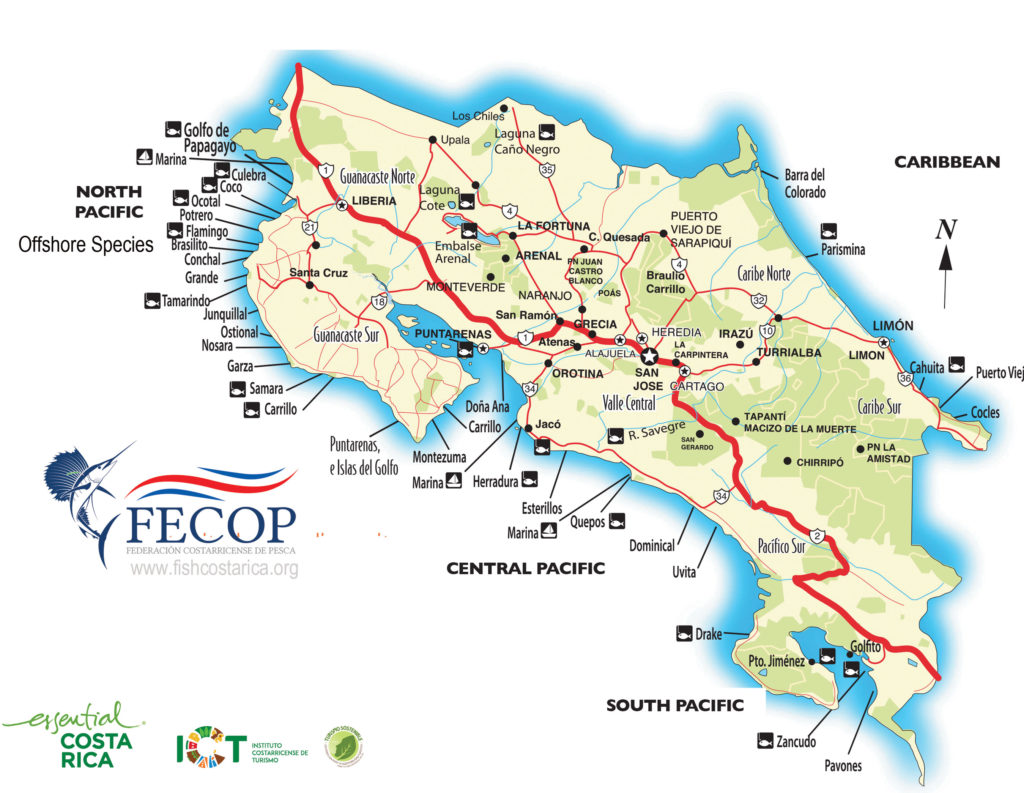
Where to take your fishing trip
Taken from the Tico Times article – Costa Rica Fishing – Where to Go, What You’ll Find by Todd Staley
Caribbean Side – Tarpon and Snook Fishing
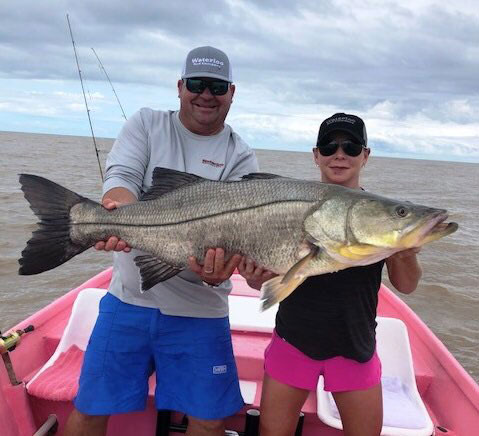
Tarpon Costa Rica’s Caribbean side is world-famous for tarpon and snook. Tarpon school up outside the mouth of the river in pods that cover several acres. When it is hot, it is red hot and you will pull on big fish all day. As mentioned above, they will also enter the rivers and back lagoons.
The fishing in the ocean is done with lures or sardines on circle hooks. Inside the mouth of the river, it is almost always done with artificial lures. The late Bill Barnes made fly fishing for tarpon popular in the area.
Snook are also taken in the rivers and lagoons as well as the beach. There are four species of snook on the Caribbean side. The fat snook (calva) run that starts in December offers a chance to catch lots of snook on light tackle. It is a smaller species of snook and averages 5 to 8 pounds. The monsters that made Costa Rica famous in the fishing world are usually taken off the beach at the rivermouth. Rarely will you see lots of fish, but you have a chance to tangle with a once-in-a-lifetime fish of 35 pounds or more.
Check out this Costa Rica fishing video featuring a Tarpon getting some serious air
Read about Costa Rica’s Snook King – Or the FECOP featured Tarpon Captain of the month Eddie Brown
Central and South Pacific
The Pacific side of Costa Rica boasts two fishing seasons for sailfish and marlin, with the central and southern regions most productive November through April.
Along with the billfish in the bluewater are tuna, and wahoo. Tuna have made a great comeback after the area in which purse seiners are allowed to work was reduced 200,000 square kilometers in 2014, and the reduction of purse sein licenses granted to foreign fleets was reduced from 43 to 13 in 2017. There have been phenomenal catches of marlin around man made marine eco-systems. You probably won’t see a grander (a marlin over 1000 lbs) here in Costa Rica, but the Pacific offers blue, black, and striped marlin.
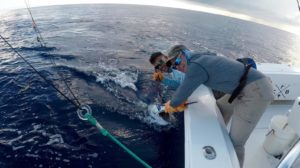
Roosterfish are the Holy Grail inshore on the Pacific side, and are available there all year, unlike other areas. The average is 10-15 lbs, but 50-lb fish are common. Also available inshore are a large variety of snappers, grouper, jacks, African pompano and others. When the water is clear, wahoo and dorado venture close to shore. Roosters, snook, jacks and snapper can be taken here casting from the beach.
North Pacific – Guanacaste
Important note – IF you are fishing in the North of Costa Rica you will fly into Liberia Int. Airport – Not Costa Rica’s Capital City (SJO)
In the North, the inshore is similar to the South with the good billfish/ offshore bite from May through December.
Fishing on Lakes and in Rivers
Guapote (rainbow bass) are available in Lake Arenal, along with machaca, a relative of the South American piranha that is quite acrobatic when hooked. The rivers and lagoons in Los Chiles, which is in the Northern Zone, and all along the Caribbean seaboard have those species as well, plus tarpon and snook that also venture deep into the freshwater ecosystems. Several types of other cichlads, known as morjarra are found deep in the jungle and make for great ultra-light fun.

High in the mountains that divide the Pacific coast from Cartago, known as the Cerro de la Muerte, anglers will find wild rainbow trout in almost every creek. In that region, San Gerardo de Dota is a popular area and is also great for birdwatching species like the elusive quetzal. Fishing in a National Park is not permitted, so check that the area you are in is not park property.
If you would like to take the kids, there are trout hatcheries along the Pan American Highway, which runs through the Cerro de la Muerte. You can fish at those hatcheries and they charge you by weight. Stone Mountain Outdoors in Santa Ana has good information on trout fishing.
Costa Rica fishing Lodges vs Charters
The choice between a fishing lodge or resort and charter boat in Costa Rica is usually a matter of preference. In a lodge your meals are usually included, you can relax in a pool and or get a massage in between your fishing days and your bed is usually only a 5-10 minute walk to the pier or boat. On the other hand you may just be in a hotel near the water and get the itch to do a day or half day of fishing. These days any captains or lodges with a good reputation will probably be booked months or weeks in advanced, although your chances of getting on a charter if you happen to be roaming freely around Costa Rica on a general vacation are better than finding a fishing lodge with space and available boats. Also staying in a lodge for 3 to 5 days of fishing lets you get aquainted with the locals and allows more time for relaxing and spending time with your significant other, friends or family as opposed to fishing charters. However some of the best charter fishing captains in the world can be found at Los Suenos Resort and Marina in Herradura and Marina Pez Vela in Quepos – In the North the Marina Papagayo is world class
From the Article Getting the Most Out of Your Costa Rica Fishing Trip by Todd Staley
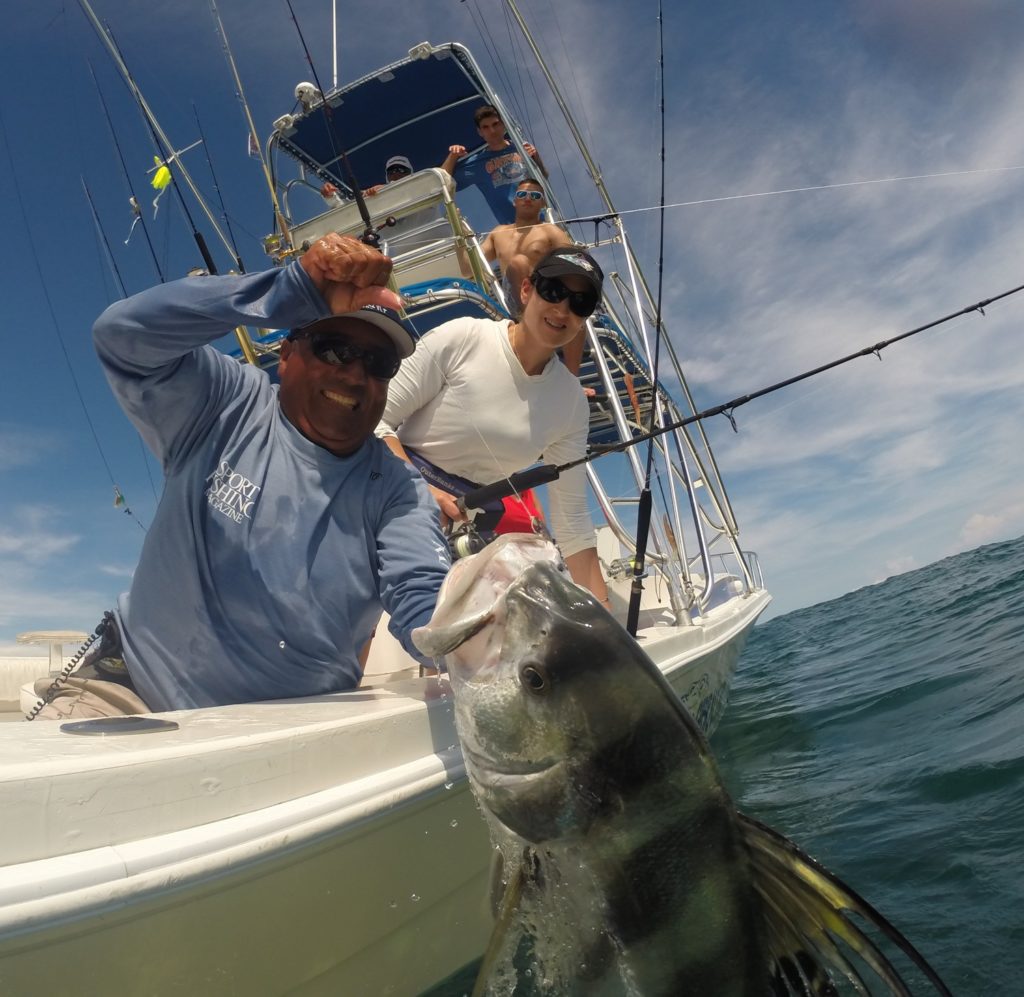
Communication is Key
“Communication during and before your Costa Rica fishing trip is VERY important” – Todd Staley
Once you have found a captain/boat/lodge with a good reputation, that offers the target spcecies you’re looking for during the time of year you are planning your vacation remember, communication before, and during your trip is the most important part of having a good fishing experience. Email the director of the fishing lodge or captain of your boat before visiting. Make sure you both know what the expectation is. Find out if you can bring your own gear, what condition the boats are in, what kind of boats, do they supply a fishing license and is it included in the cost. find out if they have a website with monthly fishing reports so you can see what the results have been for your fishing species by month through various calendar seasons. Most really good captains and lodges will have reviews all over online and in places like TripAdvisor. Keep in mind consistency is key when looking at captain/lodge production. Booking direct with the lodge and or captain is always the best option.
If you booked through a travel agent ask for the phone number or e-mail of the operator, or even the captain and talk to them. Ask what kind of boat you will be on, what type of equipment they use, what methods they use and if it is important to you, what level of English do their crews speak.
Once onboard talk with the crew and ask questions. Talk about your own level of experience. Leave your ego in your suitcase. If your home is full of trophies from fishing tournaments, but you have never fished sailfish or marlin, let your crew know. Most crews will give you as much or as little help as you want, but you have to communicate that to them.
Bait and Switch and Circle Hooks
Almost all captains in Costa Rica use a “bait and switch” method of trolling for billfish. The fish pops up in the teasers and the mate reels in the teaser with the fish in hot pursuit. As the fish moves in closer to the boat, the angler pitches a bait in the water and drops it back to the fish. The teaser is than jerked from the water leaving the bait as the only option for the fish to grab a quick meal. The same method applies to fly fisherman – and if you haven’t tried billfish on a fly your literally missing the boat.
You are required by law to use circle hooks in Costa Rica when fishing with live or dead bait. The design allows the hook to set itself without jerking the rod. Actually they are a very effective method of hooking fish while causing the least amount of damage to the fish for a safe release.
Circle hooks are not something new. They have been found made from seashells in the burial grounds of pre Columbian Indians as well as in Pacific coast Native American burial grounds. The Japanese made them long ago out of reindeer horns.
They are really quite easy to use if you plant this in your brain. Crank…Don’t Yank!!! If you are not familiar with circle hooks ask your crew to explain them before fishing.
Fishing with Kids
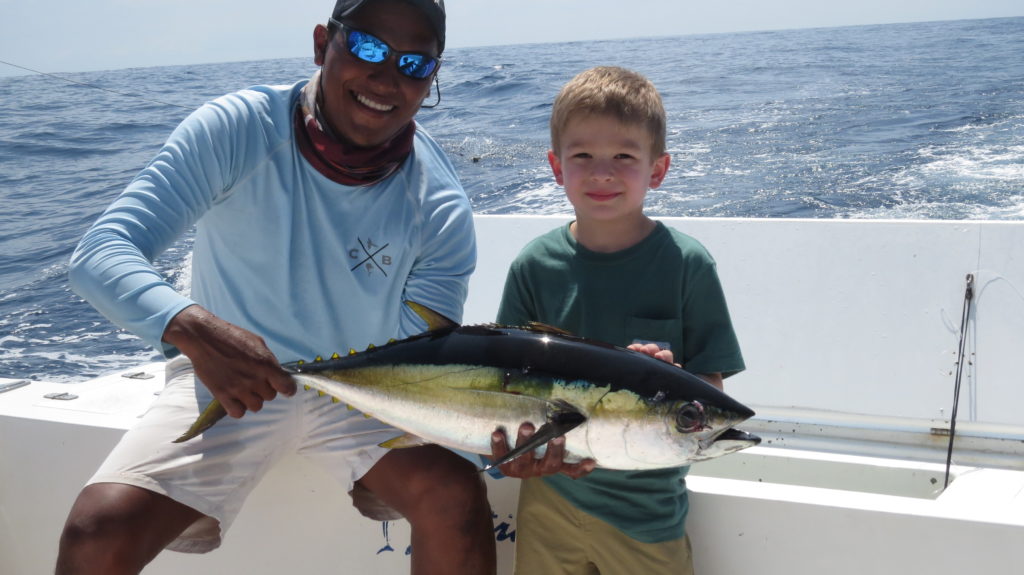
Costa Rica just ranked 2nd in TOP 6 Destinations to take your family fishing by Sport Fishing Magazine. Full Article Here
If you are bringing kids that’s great. You’ll get them hooked on a great sport for life and they will experience a new culture and experiences that will last a lifetie. Read the full article about what to expect when taking kids of all ages here Why Costa Rica is the perfect place to take your kids fishing
Costa Rica Fishing Laws and Regulations
DON’T TAKE THE BILLFISH OUT OF THE WATER – Here’s Why The Evolution of the Hero Shot
- Do I need a fishing license? Yes and you can get one online here
- Don’t take billfish out of the water (Hero Shot) – it’s illegal
- All live bait require the use of circle hooks
- Release all roosterfish
- Catch limit 5 per boat (all non-protected species)
- We strongly recommend not getting in the water with billish for photos – you become part of the food chain, their bills can be deadly, and there is lots of line and rigging in the water that you can get tangled in. Don’t be “that” guy who gets the Darwin Award and a million youtube views for being stupid
- Catch and release reef fish, unless you have a medium sized non juvenile that is considered good table fare. This is a personal matter and varies from angler to angler. We release almost all fish and no more than 3-5 per boat no matter how many anglers.
If you haven’t yet, please sign our petition to stop industrial, foreign, illegal fishing in Costa Rica here – We like to keep our fisheries healthy
At the End of Your Fishing Trip – Take it All In – You Have Just Experienced Something Truly Amazing
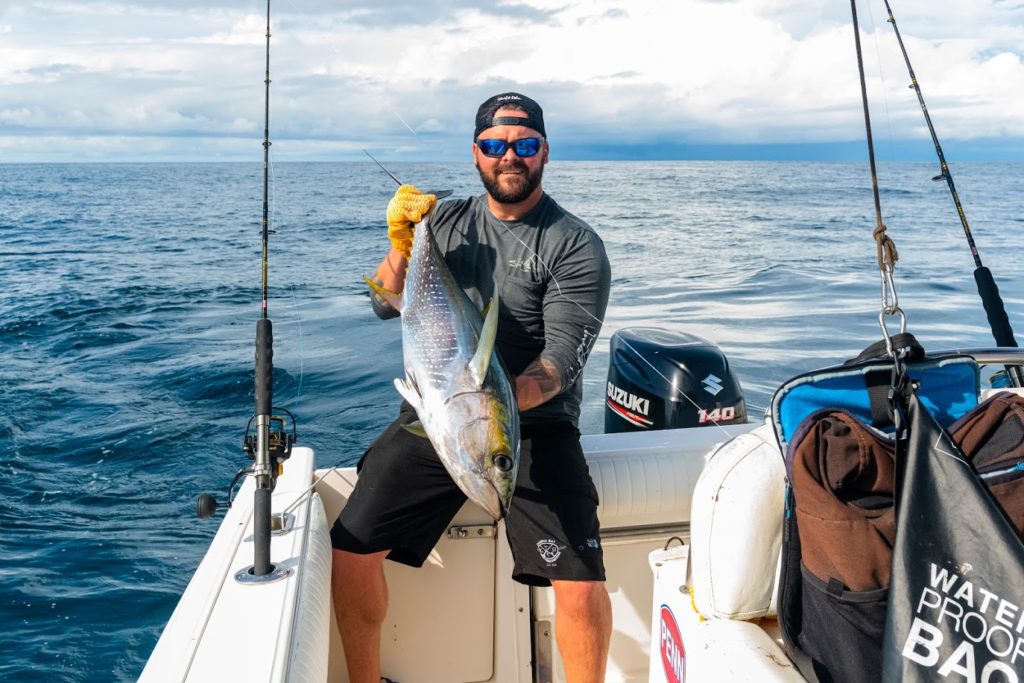 9 times out of 10 Costa Rica will prove to be a great fishing destination and you will have a good time. You will experience a wonderful and diverse culture along the way. Just like anywhere there are very nice people in Costa Rica with a few jerks mixed in. Be polite, don’t condescend and you will get along with the locals just fine. You will also learn a thing or two about fishing Costa Rican waters from your captain and crew as they have grown up here and have fished in Costa Rica all of their lives. As mentioned earlier, Ticos are very competitive and want that fish as much, if not more than you do. If you don’t get your dream fish …Blame in on the moon, bananas on the boat or your partner who puked on the boat – maybe the blue water was hard to find or a zillion other possibilities. Sometimes like anywhere you may get a green captain or crew…let your tip reflect that…everybody starts somewhere (again research and communicate with your captain and crew before your trip- know exactly what you’re getting into) Actually I’ve seen anglers blame bad fishing on everything from the hotel they’re staying at, to the captain or mate, dry rotted line or fishing gear, to the country to their wife…I’ve even heard “well, I just found out there were bananas in my pancakes” it’s the chefs fault”. People who fish are generally superstitious…if you are too here’s a link fishing explaining why bananas on the boat are bad luck.
9 times out of 10 Costa Rica will prove to be a great fishing destination and you will have a good time. You will experience a wonderful and diverse culture along the way. Just like anywhere there are very nice people in Costa Rica with a few jerks mixed in. Be polite, don’t condescend and you will get along with the locals just fine. You will also learn a thing or two about fishing Costa Rican waters from your captain and crew as they have grown up here and have fished in Costa Rica all of their lives. As mentioned earlier, Ticos are very competitive and want that fish as much, if not more than you do. If you don’t get your dream fish …Blame in on the moon, bananas on the boat or your partner who puked on the boat – maybe the blue water was hard to find or a zillion other possibilities. Sometimes like anywhere you may get a green captain or crew…let your tip reflect that…everybody starts somewhere (again research and communicate with your captain and crew before your trip- know exactly what you’re getting into) Actually I’ve seen anglers blame bad fishing on everything from the hotel they’re staying at, to the captain or mate, dry rotted line or fishing gear, to the country to their wife…I’ve even heard “well, I just found out there were bananas in my pancakes” it’s the chefs fault”. People who fish are generally superstitious…if you are too here’s a link fishing explaining why bananas on the boat are bad luck.
Let FECOP Know about Your Trip!
Did you just come back from a Costa Rica fishing trip that you loved or hated? We would like to know about it! Please leave comments below and send us photos. We will not post pictures of dead sailfish or hero shots with the sailfish or marlin on the boat. We hope you had a great, repsonsible fishing trip in Costa Rica. Please visit again soon and tell your friends!
About FECOP – The Voice of Sport Fishing in Costa Rica
More than 60,000 direct and indirect jobs, as well as a contribution of 330 million dollars to Costa Rica’s gross domestic product, are among the benefits obtained from Sport Fishing activities in Costa Rica. Help us lead the charge for sustainable fishing practices. Your responsible fishing trip in Costa Rica will help families, and keep fisheries sustainable. The government knows Sport Fishing is more beneficial than harmful non-sustainable fishing practices. Read this article explaining why live sailfish is worth much more than a dead sailfish.
Conservation through Education, Science and Research
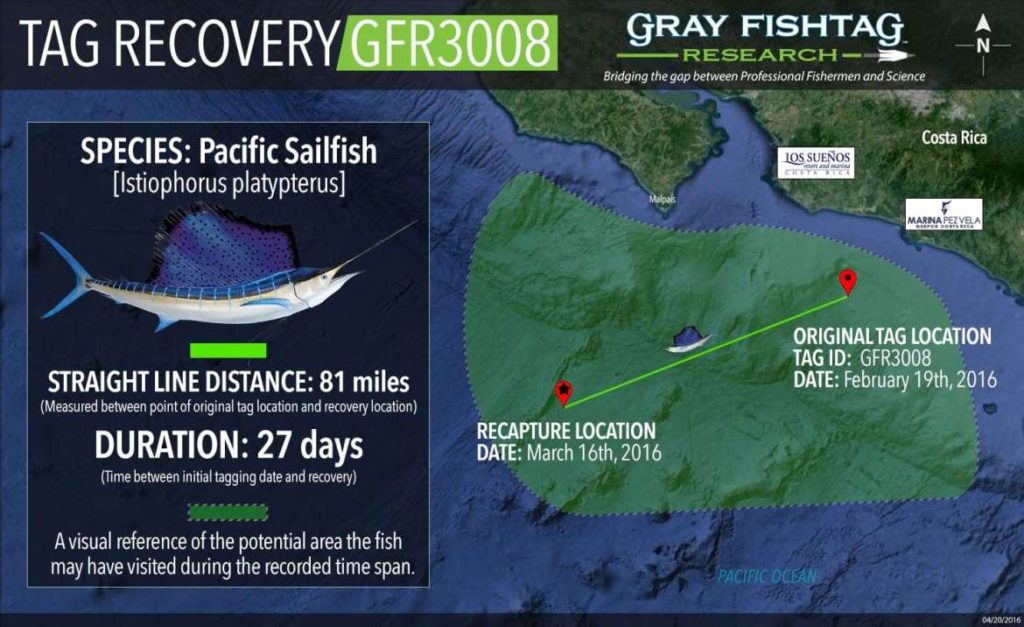
IF you’re interested in tagging and naming a billfish or roosterfish check out the Gray FishTag Research project here
Pura Vida
FECOP Staff Contributor
Don’t miss these feature articles!
[post-carousel-pro id=”5669″]
Related Fishing Articles
How to Catch Sailfish in Costa Rica
How to Catch Yellowfin and Bigeye Tuna in Costa Rica
Costa Rica Fishing Questions Answered FAQ
Explaining the Costa Rica Tuna Decree
Are Cubera Snapper Making a Comeback?
Why Costa Rica is the Perfect Destination to Take the Kids Fishing
Billfish Angler’s Guide to Costa Rica
Is Costa Rica Fishing Good Year Round?
First Sailfish On The Fly – Costa Rica Fly Fishing
Join Our Mailing List!

